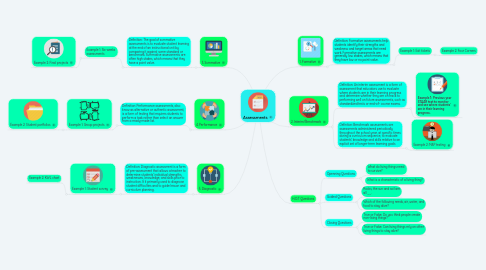
1. 3. Summative
1.1. Definition: The goal of summative assessments is to evaluate student learning at the end of an instructional unit by comparing it against some standard or benchmark. Summative assessments are often high stakes, which means that they have a point value.
1.1.1. Example 1: Six-weeks assessments
1.1.1.1. Example 2: Final projects
2. 4. Performance
2.1. Definition: Performance assessments, also know as alternative or authentic assessment, is a form of testing that requires students to perform a task rather than select an answer from a ready-made list.
2.1.1. Example 1: Group projects
2.1.1.1. Example 2: Student portfolios
3. 5. Diagnostic
3.1. Definition: Diagnostic assessment is a form of pre-assessment that allows a teacher to determine students' individual strengths, weaknesses, knowledge, and skills prior to instruction. It it primarily used to diagnose student difficulties and to guide lesson and curriculum planning.
3.1.1. Example 1: Student survey
3.1.1.1. Example 2: KWL chart
4. 1. Formative
4.1. Definition: Formative assessments help students identify their strengths and weakness and target areas that need work. Formative assessments are generally low stakes, which means that they have low or no point value.
4.1.1. Example 1: Exit tickets
4.1.1.1. Example 2: Four Corners
5. 2. Interim/Benchmark
5.1. Definition: An interim assessment is a form of assessment that educators use to evaluate where students are in their learning progress and determine whether they are on track to performing well on future assessments, such as standardized tests or end-of- course exams.
5.1.1. Example 1: Previous year STAAR test to monitor and see where students' are in their learning progress.
5.2. Defintion: Benchmark assessments are assessments administered periodically throughout the school year, at specific times during a curriculum sequence, to evaluate students' knowledge and skills relative to an explicit set of longer-term learning goals
5.2.1. Example 2: MAP testing
6. H.O.T Questions
6.1. Openning Questions
6.1.1. What do living things need to survive?
6.1.2. What is a characteristic of a living thing?
6.2. Guided Questions
6.2.1. Rocks, the sun and soil are all ________.
6.2.2. Which of the following needs, air, water, and food to stay alive?
6.3. Closing Questions
6.3.1. True or False: Do you think people create non-living things?
6.3.2. True or False: Can living things rely on other living things to stay alive?

